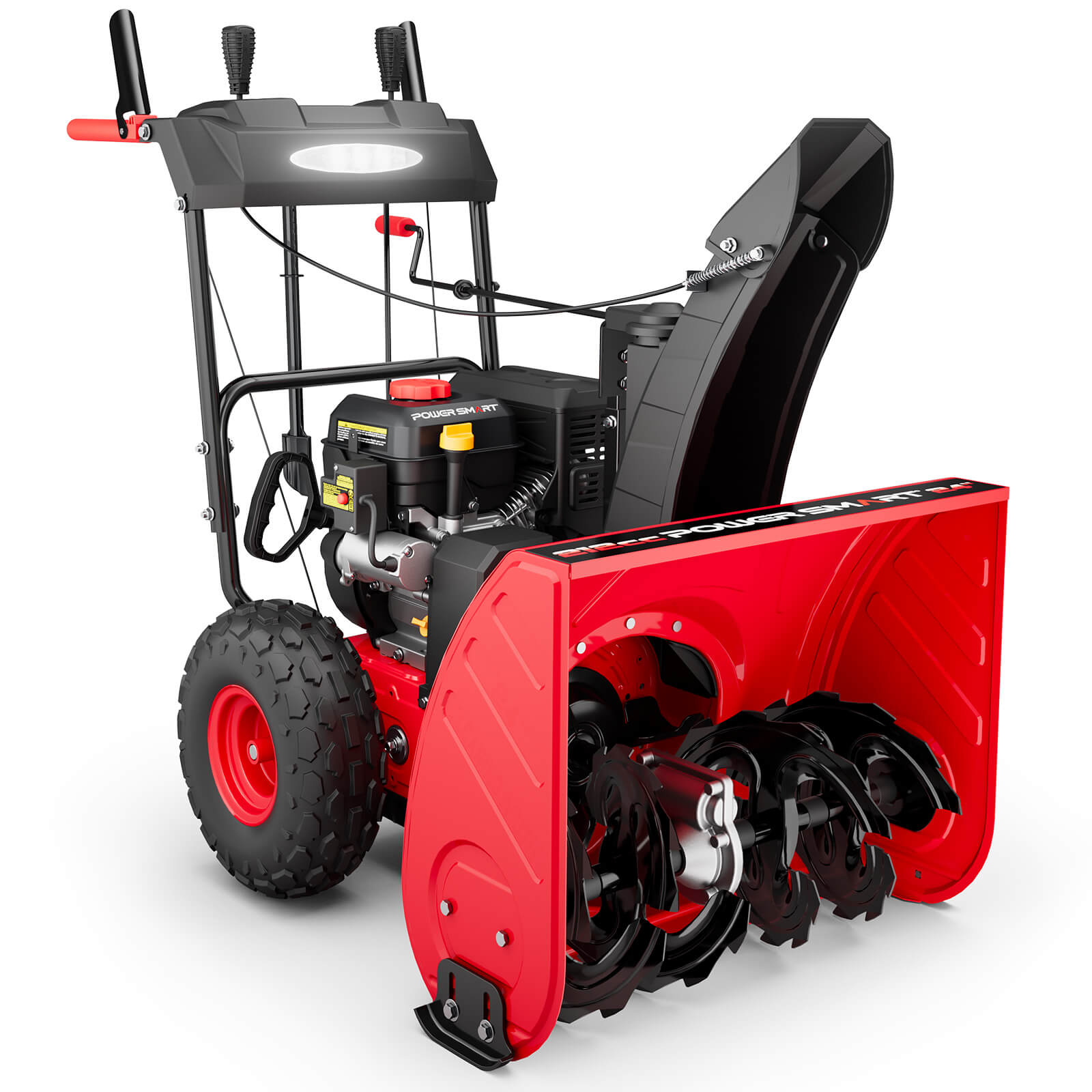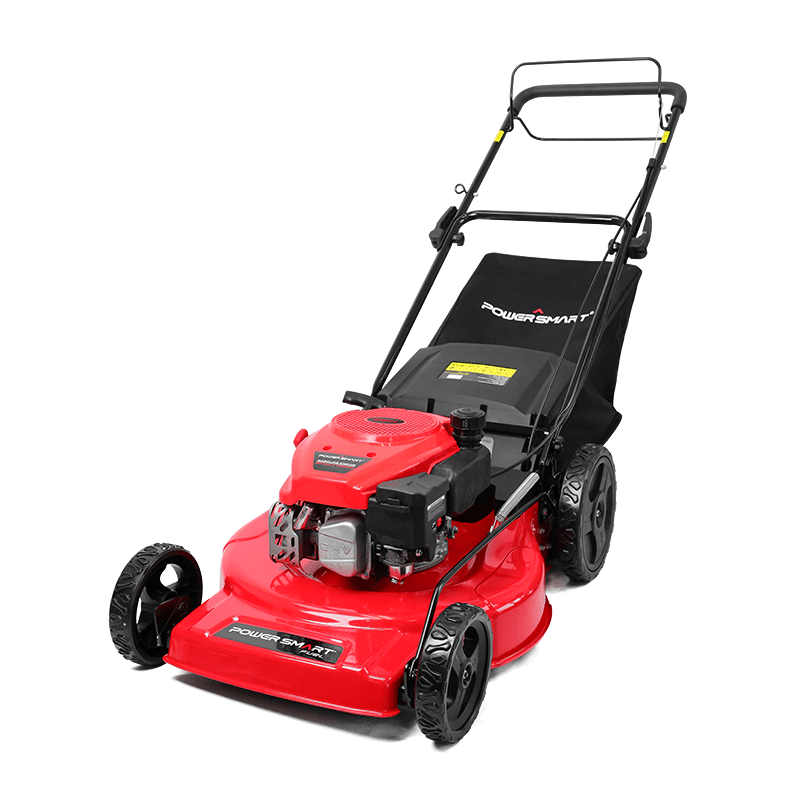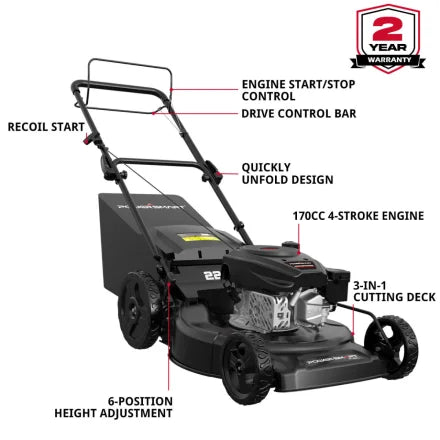Preparing for Safe Operation of a Gas Lawn Mower
Inspecting the Lawn Mower Before Use
Before using your gas lawn mower, check it thoroughly. This ensures safe and smooth operation. Look for visible damage, like cracks or loose parts. Examine the blade for sharpness. Check for wear or damage. A dull blade affects cutting quality. It also poses risks. Ensure wheels are firmly attached. Verify they are in good shape.
Test all safety features. These include the blade brake and engine stop lever. They must work properly. Regular upkeep is vital for performance. Clean the mower deck. Remove grass clippings and debris. These can block airflow or cause rust. Follow the user manual for maintenance tips. This includes oil changes and air filter swaps. PowerSmart lawn mowers have sturdy steel decks. Their blades deliver clean cuts. They ensure lasting performance.
Ensuring Proper Fuel Handling and Storage
Safe fuel handling is key for a gas lawn mower. Use fresh gasoline. Choose the octane rating advised by the maker. Avoid filling the tank too much. Spills are dangerous. They harm the environment. Store gasoline in approved containers. Keep them away from heat or flames.
Refuel when the engine is off and cool. This prevents accidental fires. Learn how to use the primer bulb or choke lever. This helps with starting. PowerSmart gas mowers have recoil starters. They also feature auto choke systems. These make starting easy.
Wearing Appropriate Protective Gear
Safety gear is a must for mowing. Wear strong shoes with grip soles. They protect feet from debris. They offer stability on rough ground. Long pants and gloves guard skin. They prevent cuts from flying objects or sharp edges.
Eye protection is vital. It shields against dust, clippings, or stones thrown by the mower. Gas mowers are loud. Hearing protection is wise. It prevents damage from long-term noise exposure.
Safe Practices While Operating a Gas Lawn Mower
Maintaining a Safe Distance from People and Pets
Keep others safe while mowing. Children, pets, and bystanders should stay 50 feet away. Flying debris can injure anyone nearby. If someone approaches, stop the engine. Wait until they are safely out of range.
Avoiding Hazardous Obstacles on the Lawn
Check your lawn before mowing. Look for rocks, sticks, or toys. These can become dangerous projectiles. Remove them for a smooth cut. This also reduces wear on the mower.
For thick grass or uneven lawns, adjust the cutting height. PowerSmart mowers have dual-lever height settings. They range from 1.5 to 3.9 inches. This suits different grass types. It ensures the best gas lawn mower performance.
Handling Slopes and Uneven Terrain Safely
Mowing on slopes needs care. Push the mower across the slope, not up or down. This gives better control. It reduces tipping risks. Avoid steep slopes if possible.
For a self propelled gas lawn mower, use rear-wheel drive. PowerSmart models offer strong traction on tough terrain. This makes inclines easier to handle safely.
Using the Self-Propelled Function Responsibly
A self propelled gas lawn mower saves effort. But it needs careful use. Always keep control. Adjust speed to match your comfort and conditions. PowerSmart self-propelled mowers have foldable handles. They store compactly. They blend power with user-friendly features. This prioritizes safety.
Frequently Asked Questions
What is the best gas lawn mower for small yards?
For small yards, try compact models like PowerSmart’s 17-inch 144cc Gas Push 3-in-1 Lawn Mower. Its size suits tight spaces. It offers versatile cutting options.
Are self-propelled gas lawn mowers worth it?
Yes, they cut physical strain. They’re great for big yards or rough terrain.
How often should I inspect my gas lawn mower?
Check before each use. Spot issues early. Follow the manual for routine care.
What type of fuel should I use in my gas lawn mower?
Use fresh gasoline. Match the octane rating in the maker’s guide.
Explore more about innovative PowerSmart products designed for efficient outdoor care solutions on their official website.
Post-Operation Safety Measures
Turning Off and Storing the Lawn Mower Properly
After mowing, shut down the gas lawn mower safely. Turn off the engine. Let it cool fully before touching or moving it. This avoids burns or fuel vapor ignition. Disconnect the spark plug wire. This prevents accidental starts during upkeep or storage.
Store the mower in a dry, airy spot. Keep it away from heat or flames. For long-term storage, drain the fuel tank. Or add a stabilizer. This stops gasoline from clogging parts. PowerSmart gas mowers have steel decks. These resist rust when stored well. Place the mower on a flat surface. Cover it with a protective sheet. This blocks dust and moisture.
Cleaning the Mower Safely After Use
Clean your gas lawn mower after each use. This maintains performance and safety. Disconnect the spark plug wire first. This prevents accidental starts. Use a brush or cloth to clear grass, dirt, and debris. Clean the deck, blades, and wheels. Be careful with blades. They stay sharp even when off.
For deep cleaning, use a garden hose. Rinse off tough debris. Avoid spraying the engine or air filter. This prevents damage. PowerSmart mowers have accessible parts. This simplifies cleaning. Regular cleaning boosts efficiency. It also cuts wear from debris buildup.
Regular Maintenance for Long-Term Safety
Routine care ensures a gas lawn mower’s safety and reliability. Check oil levels often. Replace oil as the maker advises. Inspect the air filter for dirt. Clean or replace it to keep the engine running well.
Sharpen blades regularly. This ensures clean cuts. It reduces engine strain. Check belts, cables, and moving parts for wear. Lubricate them as the manual suggests. This keeps them smooth.
PowerSmart mowers come with warranties. Their team helps with upkeep questions. This keeps your best gas lawn mower in top shape for years.
Common Hazards Associated with Gas Lawn Mowers
Risks of Fuel Leaks or Spills
Fuel leaks or spills are common dangers. Overfilling the tank causes spills. So does a loose fuel cap. Spilled gasoline risks fires. It can also harm plants or soil.
Refuel in an open outdoor area. Stay away from sparks or flames. Use an approved fuel container with a precise spout. PowerSmart gas mowers have easy-access tanks. These reduce spill risks during refueling.
Potential Injuries from Moving Parts
Moving parts, like blades, can cause serious harm. Contact with spinning blades risks cuts or worse. Always be cautious during use and upkeep.
Turn off the engine before checking under the deck. Disconnect the spark plug wire. Keep hands and feet clear of blade areas while mowing. Ensure safety shields are in place. PowerSmart mowers have blade brakes. These stop blades fast when needed.
Dangers of Overheating or Fire
Overheating is a risk with gas mowers. Long use without breaks heats engines. This raises fire risks near dry grass or debris.
Monitor the mower’s temperature. Let it cool on hot days. Clean cooling fins often. Ensure good airflow around engine parts. Store gasoline safely. Keep it away from heat to cut fire risks.
Frequently Asked Questions
What is the best gas lawn mower for medium-sized yards?
For medium yards, try PowerSmart’s 21-inch 144cc Gas Push 3-in-1 Lawn Mower. It has versatile cutting options. It suits varied needs.
How can I safely store my self-propelled gas lawn mower?
Disconnect the spark plug wire. Drain fuel for long storage. Cover with a sheet. Store in a dry spot away from heat.
What should I do if my gas lawn mower overheats?
Turn off the engine. Let it cool fully. Check for clogged fins or blocked airflow.
Are self-propelled gas lawn mowers safer on slopes?
Yes, they offer better traction than push mowers. Mow across slopes for stability.
If you need to know more about efficient lawn maintenance equipment, contact PowerSmart® now!







Leave a comment
All comments are moderated before being published.
This site is protected by hCaptcha and the hCaptcha Privacy Policy and Terms of Service apply.